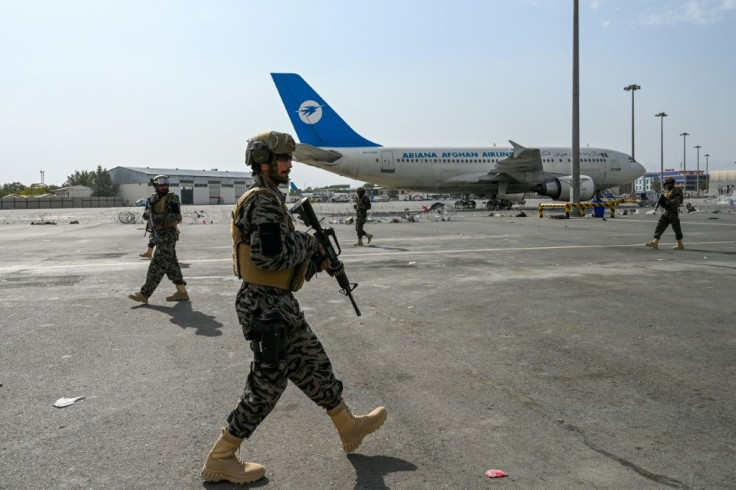Leaks Show Bureaucratic Inertia At Biden White House As Taliban Descended On Kabul
KEY POINTS
- The leaked notes suggest U.S. officials were still in a meeting while the Taliban moved closer to Kabul
- The meeting took place on Aug. 14 and the Taliban seized the Afghan capital on Aug. 15
- NSC spokesperson Emily Horne said the notes undermine government efforts that were already underway
Leaked documents from a meeting at the White House Situation Room hours before the Taliban infiltrated Kabul in mid-August show that the Biden administration was still discussing necessary actions to evacuate thousands of people even as the militant group moved to seize the Afghan capital.
Taliban fighters captured Kabul and other Afghan territories two weeks before the U.S. completed its military withdrawal.
In the notes obtained by Axios from the Aug. 14 meeting of National Security Council (NSC) officials, it was revealed that officials “agreed on the priority given to the U.S. Embassy personnel, U.S. citizens, and allied personnel with whom the U.S. Government has agreements for evacuation.”
The summary notes indicated a lack of urgency in implementing plans to get as many people out safely before the Taliban took over Afghanistan’s capital, largest city, and the country’s political and economic hub, the outlet reported.
Hours before the Taliban seized control of Afghanistan's capital, senior Biden administration officials were still discussing and assigning basic actions involved in a mass civilian evacuation.https://t.co/g61RMCITE2
— Axios (@axios) February 2, 2022
According to the outlet, the meeting, held from 3.30 to 4.30 p.m., included top aides to Cabinet members, and these people, members of the so-called Deputies Small Group, were responsible for organizing the practical details of executing decisions made by higher authorities. During the time the meeting was ongoing, Taliban fighters were making their way into Kabul.
When asked by Axios regarding the meeting summary notes, NSC spokesperson Emily Horne said that “cherry-picked notes from one meeting do not reflect the months of work that were already underway.” Horne added that the administration launched “Operation Allies Refuge,” which aimed to help locate Afghan partners faster.
“It was because of this type of planning and other efforts” that plans to evacuate people from the troubled country were facilitated, Horne argued.
"We will do it responsibly, deliberately, and safely."
— DW News (@dwnews) April 14, 2021
US President Joe Biden announced the withdrawal of troops from Afghanistan, starting May 1. pic.twitter.com/COuecSFNid
Also on Aug. 14, President Joe Biden said from the White House that the withdrawal of American troops from Afghanistan would not be “a hasty rush to exit. We’ll do it responsibly, deliberately, and safely.” By Aug. 15, the Afghan capital had fallen into the militant group’s control.
Thousands of people thronged the Kabul airport on Aug. 16 after the capital was seized by the Taliban. Footage from the scene showed a group of people clinging desperately to a U.S. military jet as it left the runway, Reuters reported.
Later that month, at least 60 Afghans and 13 U.S. Service members were killed after two suicide bombers and gunmen carried out an attack outside Kabul’s airport, Associated Press reported. The Islamic State group claimed responsibility for the said attacks.
The desperation is real in Afghanistan after the country fell to the Taliban over the weekend.
— Xavier Hershovitz (@XHershovitzTV) August 16, 2021
Right now the U.S. is attempting to secure the airport to continue these evacuations. pic.twitter.com/vLb5ITmh94
President Joe Biden on Sunday met with the families of those killed in a suicide bombing outside the airport in Kabul as the 13 service members made their final trip home. https://t.co/x4QwRClKZW pic.twitter.com/6vKQz1qXEv
— USA TODAY (@USATODAY) August 29, 2021
On the day Kabul fell into Taliban rule, Bill Roggio, a senior fellow at the Foundation for Defense of Democracies, told CNBC’s “Squawk Box Asia” that the Taliban’s speedy takeover of Afghanistan was “an intelligence failure of the highest order.” He said it appeared that the U.S. military intelligence failed in assessing the urgency of the situation.
The United States completed its military withdrawal from Afghanistan on Aug. 30, marking the end of a two-decade presence in the country.

© Copyright IBTimes 2025. All rights reserved.




















